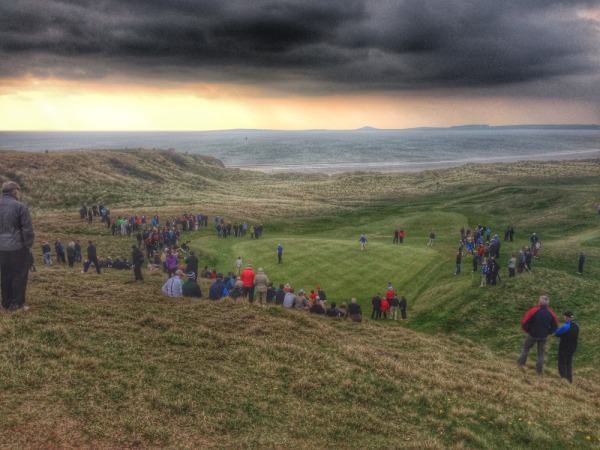Rosses Point renovation yields buried treasure
A Silvertown gutty similar to the ball found at County Sligo
If golf courses could talk, what tales they could tell. And yet, like the ruins of antiquity, a little archeology can reveal a great deal about those who went before us. So it has proved at County Sligo Golf Club, where golf course architect and writer Pat Ruddy unearthed a 19th century gutta-percha ball when creating the new third green at the famed Rosses Point links.
The find — a Silvertown gutta percha ball — hails from the 1894-1900 period that happily co-incides with the Klondike Gold Rush and is as precious to any golfing historian as a golden nugget as it was almost certainly lost by a golfer playing Rosses Point's original nine-hole course.
Jack Hume wins this year's West of Ireland Amateur Open on the 18th green at Rosses Point. In the background, the "old coast guard hut" where the new third green has been created.
“I found the gutty when applying finishing touches to the new third green at Rosses Point,” explains Pat, who is busy carrying out phase one of a major renovation of the course redesigned by Harry Colt in 1927.
“When I got off my machine in the dusk I did my customary scout about picking up golf balls revealed in the dig, and there was the Silvertown gutta percha ball quite definitely lost by one of the earliest County Sligo golfers between 1894 and 1900.
“The game started in Rosses in 1894 on a 9-hole course circling about what is now the clubhouse on the flattish lands from the practice area, 18th fairway and across the now 3rd and 1st fairways.
“Our new 3rd green is behind the existing 3rd green and near the old coast guard hut, bang in the middle of the first links.
Outgoing Co Sligo captain Anton Murphy with the Silvertown gutta percha ball found on the site of the new third green.
“It was dusk on the evening before the club's AGM when I found this ball. Everyone else had left for the day. Then a sort of miracle happened as two figures emerged from the gloom — the club's outgoing captain Anton Murphy (pictured) and incoming captain Aidan Doyle — to share the joys of the newly shaped green!
“There was nothing for it but to hand my new treasure over to them and there is every likelihood it will now repose in a glass case in the clubhouse while the identity of the man who lost it will remain a mystery.”
As luck would have it, a small Titleist bearing with the name "Brian Moylett" printed on it was also found at the site of the new third, much to the delight of general manager David O’Donovan.
“Brian was, of course, a famous golfer from Ballina where his family owned the famous Downhill Hotel,” Pat explains. “He played for Connacht many times and his son Michael is a recent Irish rugby international.”
As for the Silvertown gutty, it was retired between 1898 and 1902 with the arrival of the first rubber balls.
For those interested in the history of the Silvertown, here’s a brief history:
The India Rubber, Gutta Perch and Telegraph Works Co. began in 1864, when the Silver family renamed the works of S.W.Silver & Co in the area called Silvertown which was established in 1852. From around 1859 the area became known as 'Silver's Town'. It became known as Silvertown soon afterwards.
The factory at first made mostly cables but began making other products e.g. tyres and golf balls from the 1890s. Gutta percha is a natural product of trees in the Pacific countries. From 1848, golf balls made of gutta-percha gum, called ‘gutties’ began to replace featheries. Several claims are made about the origin of the gutty.
The traditional story of their creation, relates that in 1843 Robert Adams Paterson a divinity student at St Andrews, received a package from Singapore of the God Vishnu packed in gutta-percha, which is dried gum resin from guttiferous trees especially of the Malaysian sapodilla tree. It was not uncommon to make things from this gutta-percha packaging and Paterson tried heating and molding it to make golf balls.
In 1871, Willie Dunn at Musselburgh created a mould to make gutties, which was a quicker and more consistent method of production. Gutties were painted white or red for winter play, for the same reason as featheries, as protection and to be able to find them.
The cost of gutties was 1/- one shilling, much cheaper than featheries, and a main factor in bringing golf to the masses. The gutty lasted until 1900. Coburn Haskell, an American, developed a wound core ball in 1898.








